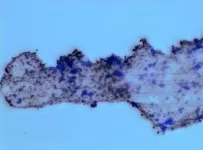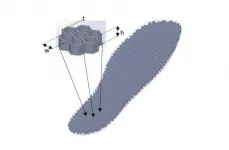(Press-News.org) GRAND RAPIDS, Mich. (JUNE 8, 2021) -- Chronic inflammation in the gut may propel processes in the body that give rise to Parkinson's disease, according to a study by scientists at Van Andel Institute and Roche.
The study, published in Free Neuropathology, is the latest in a growing list that links the gut and the immune system to Parkinson's. The researchers' findings in an experimental mouse model of gut inflammation track with several large-scale epidemiological studies that show an association between Parkinson's and inflammatory bowel diseases, such as ulcerative colitis and Crohn's disease.
Epidemiological evidence from other groups indicates the risk of developing Parkinson's fades in certain people whose inflammatory bowel disease is treated with anti-TNF, a standard-of-care anti-inflammatory therapy, which suggests that reducing gut inflammation may have promise for mitigating Parkinson's onset.
"There is increasing evidence that changes in the gut can affect a variety of neurological and psychiatric brain disorders," said Patrik Brundin, M.D., Ph.D., VAI deputy chief scientific officer and co-corresponding author of the study. "Parkinson's is a complex disease with a wide range of factors that work in concert to spark its onset and progression. We need to understand the gut's likely influence on Parkinson's development better. This study provides novel insights, and this new knowledge can facilitate the development of improved treatment approaches."
In their disease models, the team found that chronic gut inflammation triggers a protein called alpha-synuclein to clump together in walls of the colon, as well as in local immune cells called macrophages. A similar process may play out in the colons of some people -- such as those with inflammatory bowel diseases -- thereby increasing their risk to develop Parkinson's as shown in studies by other groups.
Similarly, in the brains of people with Parkinson's, "sticky" alpha-synuclein aggregates also develop. For reasons that still are unclear, these aggregates can clog the molecular machinery that keep neurons alive. The resulting loss of some of these critical cells -- and the chemical messenger they produce called dopamine -- causes Parkinson's hallmark movement-related symptoms, such as freezing and loss of voluntary movement. The additional wide-spread development of alpha-synuclein aggregates throughout the brain also may be associated with the disease's non-motor symptoms and may fuel its progression, which cannot be slowed or stopped with existing treatments.
The study also revealed that chronic inflammation in the gut early in life can exacerbate alpha-synuclein clumping throughout the brain in older mice. While it isn't clear exactly how this happens, the team has two theories: first, they suggest inflammatory chemicals may travel from the gut to the brain via the bloodstream, triggering a runaway inflammatory immune response that leads to protein aggregation. Another idea is that alpha-synuclein aggregates may travel to the brain via the vagus nerve, one of the longest nerves in the body and a "superhighway" between the gut and the brain. Once there, the proteins may then execute their toxic activity in the brain.
"We now know that systems throughout the body contribute to Parkinson's," said Emmanuel Quansah, Ph.D., a postdoctoral fellow in Brundin's lab and a key contributor and co-author of the study. "It was striking to see protein aggregation pathology in the brain that mirrored pathology in the colon brought on by inflammation. A particularly intriguing observation was the loss dopamine-producing nerve cells -- which play a major role in Parkinson's onset -- in our models that had gut inflammation a year-and-a-half earlier."
Notably, the team also found that modulating immune activation in the colitis mouse model by genetic or therapeutic means tuned the level of alpha-synuclein clumps in the colon up or down.
"Our results in mice, together with the genetic and epidemiological data by others in humans, make a strong case for further exploring systemic immune pathways for future therapies and biomarkers for Parkinson's," said Markus Britschgi, Ph.D., Senior Principal Scientist and Section Head in the Neuroscience and Rare Diseases Research Department at the Roche Innovation Center Basel and co-corresponding author of the study.
Authors include first author Stefan Grathwohl, Ph.D. (previously a Roche postdoctoral fellow), Nazia Maroof, Ph.D. (previously a Roche postdoctoral fellow), Liz Spycher, Krisztina Oroszlan-Szovik, M.S., Helga Remy, Markus Haenggi M.S., and Marc Stawiski of Roche Pharma Research and Early Development, Neuroscience and Rare Diseases Discovery and Translational Area, Roche Innovation Center Basel; Jennifer A. Steiner, Ph.D., Zachary Madaj, M.S., and Martha L. Escobar Galvis, Ph.D., of VAI; Fethallah Benmansour, Ph.D., of Roche Pharma Research and Early Development, pREDi, Roche Innovation Center Basel; Gonzalo Duran-Pacheco, Ph.D., Juliane Siebourg-Polster, Ph.D., Matthias Selhausen, Pierre Maliver, EVCP, Arel Su, DVM, and Annika Herrmann, DECVP, of Roche Pharma Research and Early Development, Pharmaceutical Sciences, Roche Innovation Center Basel; Andreas Wolfert and Thomas Emrich, Ph.D., of Roche Pharma Research and Early Development, Pharmaceutical Sciences, Roche Innovation Center Munich; and Christoph Mueller, Ph.D., of Institute of Pathology, University of Bern.
INFORMATION:
Free Neuropathology is a new type of open-access journal that is run entirely by scientists working in the field.
Research reported in this publication was funded by Van Andel Institute and Roche. Early work on this project was supported in part by the European Research Council.
ABOUT VAN ANDEL INSTITUTE
Van Andel Institute (VAI) is committed to improving the health and enhancing the lives of current and future generations through cutting edge biomedical research and innovative educational offerings. Established in Grand Rapids, Michigan, in 1996 by the Van Andel family, VAI is now home to more than 400 scientists, educators and support staff, who work with a growing number of national and international collaborators to foster discovery. The Institute's scientists study the origins of cancer, Parkinson's and other diseases and translate their findings into breakthrough prevention and treatment strategies. Our educators develop inquiry-based approaches for K-12 education to help students and teachers prepare the next generation of problem-solvers, while our Graduate School offers a rigorous, research-intensive Ph.D. program in molecular and cellular biology. Learn more at END
Small pieces of plastic are everywhere, stretching from urban environments to pristine wilderness. Left to their own devices, it can take hundreds of years for them to degrade completely. Catalysts activated by sunlight could speed up the process, but getting these compounds to interact with microplastics is difficult. In a proof-of-concept study, researchers reporting in ACS Applied Materials & Interfaces developed self-propelled microrobots that can swim, attach to plastics and break them down.
While plastic products are omnipresent indoors, plastic waste and broken bits now litter the outdoors, too. The smallest of these ...
TORONTO, June 9, 2021 - Researchers from York University and the University of British Columbia have found social media use to be one of the factors related to the spread of COVID-19 within dozens of countries during the early stages of the pandemic.
The researchers say this finding resembles other examples of social media misinformation ranging from the initial phase of vaccine rollout to the 2021 Capitol riot in the United States.
Countries with high social media use leading to off-line political action prior to the pandemic, as surveyed before the pandemic by V-Dem (a database from the University of Gothenburg), showed ...
Skoltech researchers and their colleagues from RAS Institute for Physics of Microstructures, Lobachevsky State University of Nizhny Novgorod, ITMO University, Lomonosov Moscow State University, and A.M. Prokhorov General Physics Institute have found a way to increase photoluminescence in silicon, the notoriously poor emitter and absorber of photons at the heart of all modern electronics. This discovery may pave the way to photonic integrated circuits, boosting their performance. The paper was published in the journal Laser and Photonics Reviews.
"Natural selection" in semiconductor technology ...
Vertebrate life began in the water, but around 340-360 million years ago, four-limbed creatures, or tetrapods, made the transition onto land. In the years that followed, some species adapted to terrestrial life, while others turned back to the water and readapted to an aquatic lifestyle.
A new study of these early amphibians, published in the journal PLOS ONE and led by Penn paleontologist Aja Carter, suggests that these environmental shifts left an impression--on the shape of the animals' spines.
"I'm interested in how the shapes of the vertebrae affect how animals move," she says. "Our findings suggest that, in at least one part of the vertebrae, the shape of the bones ...
WEST LAFAYETTE, Ind. - Purdue University engineers have developed a method to transform existing cloth items into battery-free wearables resistant to laundry. These smart clothes are powered wirelessly through a flexible, silk-based coil sewn on the textile.
In the near future, all your clothes will become smart. These smart cloths will outperform conventional passive garments, thanks to their miniaturized electronic circuits and sensors, which will allow you to seamlessly communicate with your phone, computer, car and other machines. This smart clothing will not only make you more productive but also check on your health status and even call for help if you suffer an accident. The reason why this smart clothing ...
As many as 450,000 Americans die every year from a sudden, fatal heart condition, and in slightly more than one in ten cases the cause remains unexplained even after an autopsy. Researchers from the University of Maryland School of Medicine (UMSOM) and their colleagues found that nearly 20 percent of patients with unexplained sudden cardiac death - most of whom were under age 50 - carried rare genetic variants. These variants likely raised their risk of sudden cardiac death. In some cases, their deaths may have been prevented if their doctors had known about their genetic predisposition to heart disease. The study findings were published ...
WASHINGTON--After their initial blast, space rockets shoot away from the Earth with rumbles in infrasound, soundwaves too low to be heard by human ears that can travel thousands of miles.
New research used a system for monitoring nuclear tests to track the infrasound from 1,001 rocket launches. The research identified the distinctive sounds from seven different types of rockets, including the Space Shuttles, Falcon 9 rockets, various Soyuz rockets, the European Space Agency's Ariane 5, Russian Protons and several types of Chinese Long March rockets.
In some cases, like the Space Shuttle and the Falcon 9, the researchers were also able to identify the various stages of the rockets' journey.
https://youtu.be/IfMtEcNkkho
The ...
Smokers needed their blocked arteries fixed nearly a decade earlier than non-smokers, and patients with obesity underwent these procedures four years earlier than non-obese patients, according to a new statewide study.
The research included patients without a history of heart attack who were treated at hospitals across Michigan participating in BMC2, the Blue Cross Blue Shield of Michigan Cardiovascular Consortium. The patients had undergone angioplasty and/or stenting to widen or unblock their coronary arteries and restore blood flow. Almost all of them had at least one traditional ...
Millions of people with diabetes are at risk of developing foot ulcers, which often lead to amputations and other health complications. Now, Scientists from the Centre for Biomechanics and Rehabilitation Technologies (CRBT) have developed a new method to reliably detect this risk without the need for complex electronic in-shoe sensors.
Dr Panagiotis Chatzistergos, Associate Professor in Orthopaedic Biomechanics, explained: "In the UK alone, 169 people have a toe, foot or limb amputated as a result of diabetes every week, yet importantly up to 80% of these amputations could have been prevented with correct management.
"Routine overloading ...
New research shows what is often assumed to be 'fair' in conservation practice may not be considered so by the very people most affected by it--and a new approach is needed if protected areas are to be effective.
Lead author Dr Georgina Gurney, from the ARC Centre of Excellence for Coral Reef Studies based at James Cook University, said considering local stakeholder conceptions of fairness in conservation is critical.
"If conservation is perceived as unfair it can lead to conflict, undermining support and cooperation," Dr Gurney said.
She said it is not only an ethical matter but key to achieving good ...



